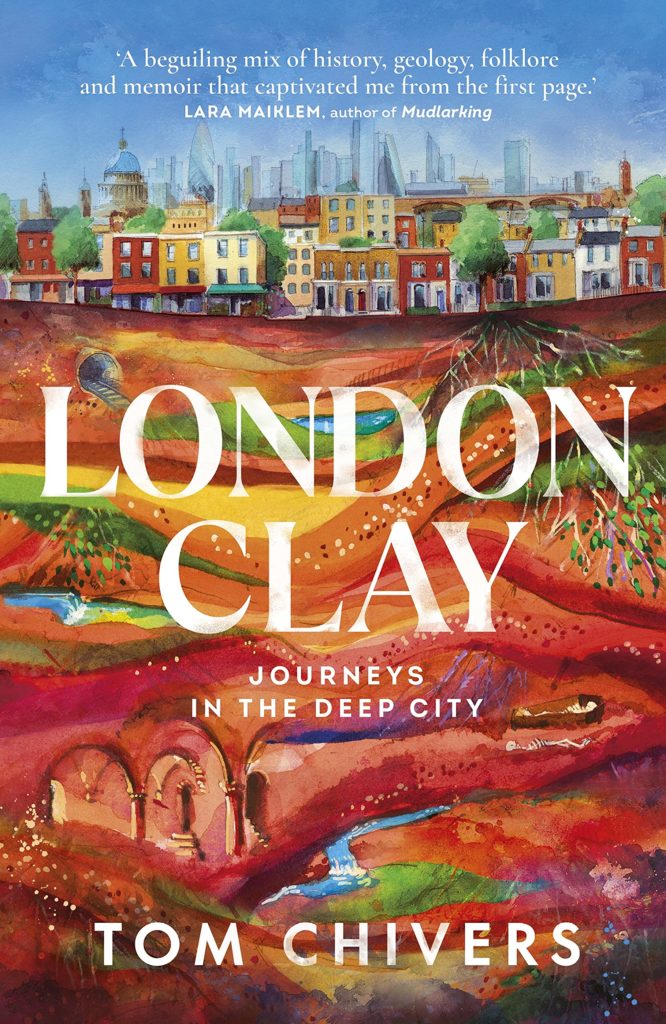In ‘London Clay’, just-published by Doubleday, Tom Chivers follows hidden pathways, explores lost islands and uncovers the geological mysteries that burst up through the pavement of the city he loves. Tom Bolton reviews.

The map of London is a fluid entity. The shops, restaurants, and features sponsored for labelling by Google are a selective city that omits anything without economic value. It leaves out the edges, the in-between, and the underneath. This version of London is more slippery. It changes behind your back, archiving itself without warning, becoming history whether you are ready or not. Hidden London carries the emotional baggage the official city rejects. Currents that flow below the pavements, some in the form of the lost river network, provide a different continuity. As conduits for memory, they are the hidden spirit of places, sometimes threatening to sweep them away altogether. Behind hoardings, under gratings, in gated alleys, in sealed tunnels, condemned shopping centres and forgotten archaeological digs, London feels, remembers and knows.
Tom Chivers is a poet, a publisher and a South Londoner, a man with his finger on the city’s cultural pulse. He has a map, which he has been building for years, tracing London’s geology onto streets shown in contourless space. In London Clay we first meet him in a flat above the Hoop and Grapes pub at Aldgate, bent over his Collins Streetfinder. Chivers is our guide to London below, with a mission to understand the hills and valleys, islands and streams that do not feature on any map. Chapter by chapter he explores the shapes London once formed, and the traces left behind. Broadly, his focus is on the south, and on areas of London often passed over by new London writing, with its preference for Zone 1 and E postcodes. He follows the routes of lost rivers – the Earl’s Sluice, the Effra, the Fleet, the Neckinger, the Tyburn and the Walbrook – that flow below the pavements from Belgravia to Brixton. The rivers help to define the geology of the places that grew up around them, before they were routed into the sewer system, but Chivers explores other mysteries too. He begins with a hole in Aldgate, a site that sits empty for years awaiting development, and explores further holes, islands, mounds and deposits and weaves them into a subterranean map of London.
But although Chivers is fascinated by lost London, and by the writers who have made it their own, London Clay is more than just a book of topography. He weaves a personal account around his expeditions, blended with the layers under his feet. Brought up, like John Ruskin, up in Herne Hill, Chivers sees the places around him from a vantage point, but his perspective was fundamentally altered by the death of his mother when he was in his early teens. She is buried in West Norwood Cemetery, on a hill above the line of the buried Effra, a site he visits as part of his mission to understand where he fits in this infinitely complex place. There is a constant sense that London has some explanation to offer, that an understanding of the city can help to decode the messy and inexplicable events that take place in it. Current events bleed into the story generating emotional weather, from the 2005 London bombings to the pandemic that traps London inside its own head, just as the book’s end is in sight. Chivers does a masterful job of writing about himself, while avoiding the over-used ‘journey’ tropes that dominate current place writing.
London Clay is a thoroughly absorbing read. Chivers writes easily, blending accounts of his walks, many taken in the company of well-chosen writers and friends, with intriguing, expertly researched insights into places we think we already know. He hones in on places that are strangely overlooked, such as the landscape of Thorney Island on which Westminster Abbey, or the Rockingham Anomaly, a mysterious geological feature north of the Elephant and Castle. He is constantly informative and questioning, looking for significance in graffiti, overheard snatches of conversation and encounters with strangers in cafes. He is fully aware of the bigger issues looming over London, at ‘gentrification ground zero’ in the newly-emerging Elephant and in the blocks of million pound flats filling the Limmo Peninsula. He also examines the detail, and the book is full of features that will register with Londoners, who probably think they are the only ones people who have noticed them: the Fulcrum sculpture at Liverpool Street Station, the hidden delights of St. Bride’s Church, the remains of the Rose Theatre, packed in plastic in a Bankside basement. Chivers’ London is the real thing: a combination of lived experience, where each location marks a different life stage, and the inexhaustible stories of the city. He accesses new levels of meaning through overlooked clues and connections made late at night, hunched over a map, which suddenly reveals secrets that have been there all along. London Clay, informed by a thorough understanding of literature and place, is a high quality piece of writing and a book that takes its place in the canon of London literature. It promises to launch a thousand urban walks.
*
‘London Clay’ is out now and available here.